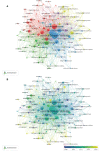The relationship between polycystic ovary syndrome and coronary heart disease: a bibliometric analysis
- PMID: 37223024
- PMCID: PMC10200869
- DOI: 10.3389/fendo.2023.1172750
The relationship between polycystic ovary syndrome and coronary heart disease: a bibliometric analysis
Abstract
Background: Polycystic ovary syndrome (PCOS) is one of the most common gynecological endocrine diseases for women of puberty and reproductive age. PCOS can affect women's health for the rest of their lives since the incidence of coronary heart disease (CHD) may increase in the perimenopausal and senile periods among PCOS women compared with non-PCOS women.
Method: A literature retrieval based on the Science Citation Index Expanded (SCI-E) database. All obtained records results were downloaded in plain text format for subsequent analysis. VOSviewer v1.6.10, Citespace and Microsoft Excel 2010 software were utilized for analyzing the following terms: countries, institutions, authors, journals, references and keywords.
Results: There were 312 articles retrieved from January 1, 2000 to February 8, 2023, and the frequency of citations was 23,587. The United States, England, and Italy contributed the majority of the records. Harvard University, the University of Athens, and Monash University were the top 3 most productive institutions with publications on the relationship between PCOS and CHD. Journal of clinical endocrinology & metabolism ranked first with the highest publications (24 records), followed by Fertility and sterility (18 records). The keywords were divided into six clusters in the overlay keywords network: (1) the correlation between CHD risk factors and PCOS women; (2) the relationship between cardiovascular disease and female reproductive system hormone secretion; (3) the interaction between CHD and metabolic syndrome; (4) the relationship between c-reactive protein and endothelial function and oxidative stress in PCOS patients; (5) the potential positive effect of metformin on reducing CHD risk factors in PCOS patients; (6) the study of serum cholesterol and body-fat distribution in patients with CHD in PCOS. Oxidative stress, genome-wide association, obesity, primary prevention, and sex difference were main hotspots in this field in recent five years according to the keyword citation burst analysis.
Conclusion: The article obtained the hotspots and trends and provided a reference for subsequent research on the association between PCOS and CHD. Moreover, it is hypothesized that oxidative stress and genome-wide association were frontier hotspots in studies that explore the relationship between PCOS and CHD, and prevention research may be valued in the future.
Keywords: VOSviewer; bibliometric analysis; citespace; coronary heart disease; polycystic ovary syndrome; risk factor.
Copyright © 2023 Liang, He, Zeng, Wei, Yang, Wen, Fan and Fan.
Conflict of interest statement
The authors declare that the research was conducted in the absence of any commercial or financial relationships that could be construed as a potential conflict of interest.
Figures








Similar articles
-
The relationship between polycystic ovary syndrome and insulin resistance from 1983 to 2022: A bibliometric analysis.Front Public Health. 2022 Jul 28;10:960965. doi: 10.3389/fpubh.2022.960965. eCollection 2022. Front Public Health. 2022. PMID: 35968428 Free PMC article. Review.
-
Bibliometric analysis of the research on anti-Müllerian hormone and polycystic ovary syndrome: current status, hotspots, and trends.Front Reprod Health. 2025 Apr 24;7:1519249. doi: 10.3389/frph.2025.1519249. eCollection 2025. Front Reprod Health. 2025. PMID: 40342310 Free PMC article.
-
Research hotspots of polycystic ovary syndrome and hyperandrogenism from 2008 to 2022: bibliometric analysis.Gynecol Endocrinol. 2024 Mar 2;40(1):2326102. doi: 10.1080/09513590.2024.2326102. Epub 2024 Apr 24. Gynecol Endocrinol. 2024. PMID: 38654639 Review.
-
Global trends in polycystic ovary syndrome research: A 10-year bibliometric analysis.Front Endocrinol (Lausanne). 2023 Jan 9;13:1027945. doi: 10.3389/fendo.2022.1027945. eCollection 2022. Front Endocrinol (Lausanne). 2023. PMID: 36699019 Free PMC article.
-
Hotspots and research trends of gut microbiome in polycystic ovary syndrome: a bibliometric analysis (2012-2023).Front Microbiol. 2025 Jan 8;15:1524521. doi: 10.3389/fmicb.2024.1524521. eCollection 2024. Front Microbiol. 2025. PMID: 39845049 Free PMC article.
Cited by
-
Knowledge mapping and global trends in the field of low-intensity pulsed ultrasound and endocrine and metabolic diseases: a bibliometric and visual analysis from 2012 to 2022.Front Endocrinol (Lausanne). 2023 Sep 5;14:1237864. doi: 10.3389/fendo.2023.1237864. eCollection 2023. Front Endocrinol (Lausanne). 2023. PMID: 37732128 Free PMC article.
-
Quality of Life of Women with Polycystic Ovary Syndrome.Medicina (Kaunas). 2024 Feb 9;60(2):294. doi: 10.3390/medicina60020294. Medicina (Kaunas). 2024. PMID: 38399581 Free PMC article.
-
Berberine Intervention Mitigates Myocardial Ischemia-Reperfusion Injury in a Rat Model: Mechanistic Insights via miR-184 Signaling.Biologics. 2025 Feb 25;19:31-42. doi: 10.2147/BTT.S479430. eCollection 2025. Biologics. 2025. PMID: 40026702 Free PMC article.
-
Trends in metabolic dysfunction in polycystic ovary syndrome: a bibliometric analysis.Front Endocrinol (Lausanne). 2023 Aug 28;14:1245719. doi: 10.3389/fendo.2023.1245719. eCollection 2023. Front Endocrinol (Lausanne). 2023. PMID: 37701893 Free PMC article. Review.
-
Visualization analysis of ovarian hyperstimulation syndrome based on bibliometrics.Medicine (Baltimore). 2025 May 16;104(20):e42342. doi: 10.1097/MD.0000000000042342. Medicine (Baltimore). 2025. PMID: 40388793 Free PMC article.
References
-
- Fauser BC, Tarlatzis BC, Rebar RW, Legro RS, Balen AH, Lobo R, et al. . Consensus on women's health aspects of polycystic ovary syndrome (PCOS): the Amsterdam ESHRE/ASRM-sponsored 3rd PCOS consensus workshop group. Fertil Steril. (2012) 97(1):28–38.e25. doi: 10.1016/j.fertnstert.2011.09.024 - DOI - PubMed
Publication types
MeSH terms
LinkOut - more resources
Full Text Sources
Medical
Research Materials

